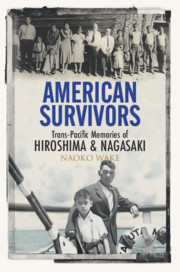Book contents
- American Survivors
- American Survivors
- Copyright page
- Dedication
- Contents
- Figures
- Abbreviations
- Notes on the Text
- Acknowledgments
- Introduction
- 1 Cities of Immigrants
- 2 Remembering the Nuclear Holocaust
- 3 Reconnecting Families
- 4 War and Work Across the Pacific
- 5 Finding Survivorhood
- 6 Endlessness of Radiation Illness
- Epilogue
- Notes
- Glossary
- Select Bibliography
- Index
Introduction
Published online by Cambridge University Press: 27 May 2021
- American Survivors
- American Survivors
- Copyright page
- Dedication
- Contents
- Figures
- Abbreviations
- Notes on the Text
- Acknowledgments
- Introduction
- 1 Cities of Immigrants
- 2 Remembering the Nuclear Holocaust
- 3 Reconnecting Families
- 4 War and Work Across the Pacific
- 5 Finding Survivorhood
- 6 Endlessness of Radiation Illness
- Epilogue
- Notes
- Glossary
- Select Bibliography
- Index
Summary
Though little-known, Japanese Americans – US-born citizens – along with Japanese and Koreans who became US citizens in the 1950s and 1960 after migrating to America, were affected by the atomic bombs. Hiroshima and Nagasaki sent a large number of immigrants to America before the war. Because of the long-standing connnction, many Japanese American children were in Japan and, indeed, in their parents’ hometown of Hiroshima or Nagasaki, when the war broke out in 1941. The other group of US survivors included “military brides,” Japanese and Korean women who married American men when these Asian countries were under the massive influence of the US military. Also included in this group were opportunity seekers, the Japanese and Koreans who came to America for jobs or schooling not available in their countries reeling from a war. Together, these survivors created a uniquely cross-national memory, identity, and activism, illuminating a surprisingly trans-Pacific history of nuclear weapons and their human consequences. By showing how US survivors richly told this largely untold history in their oral histories, the Introduction brings to light the power of personal narratives in historical understanding.
Keywords
- Type
- Chapter
- Information
- American SurvivorsTrans-Pacific Memories of Hiroshima and Nagasaki, pp. 1 - 23Publisher: Cambridge University PressPrint publication year: 2021



